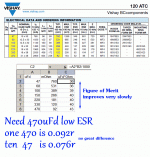From what I've read a way to reduce ESR with smoothing caps is to connect in parallel, summing capacitance yet reducing resistance (1/R, etc).
However ESR increases significantly with smaller capacitors to the point where connecting in parallel defeats the object.
example: Vishay 100uF typ ESR 1.375Ohms. so two in parallel provides 0.6875 Ohms. The typical ESR for a 220uF is 0.629 Ohms. Less! I'm sure it is something I am not seeing, would appreciate somebody pointing it out.
However ESR increases significantly with smaller capacitors to the point where connecting in parallel defeats the object.
example: Vishay 100uF typ ESR 1.375Ohms. so two in parallel provides 0.6875 Ohms. The typical ESR for a 220uF is 0.629 Ohms. Less! I'm sure it is something I am not seeing, would appreciate somebody pointing it out.
It can be quite complex. It depends how cap is manufactured. E.g. which foil is used and how much it is etched. Also the form factor of cap is important and which voltage rating it is made for. A small physical cap with relative high capacitance uses foil that is etched a lot and will have higher ESR. Generally a physical large cap that has relative low capacitance often has low ESR. E.g. smooth foil caps are large compared to their capacitance but has low ESR. Also long cylindric caps often has lower ESR than physical "fat" short cylindric caps.
Thanks for responding. I was under the impression that provided the capacitors were of the same value the equation for parallel resistance could be used, wrong.
Complex numbers, urrggh. I'll give it a go
Complex numbers, urrggh. I'll give it a go
If we have two the same capacitors, then that formula gives Z/2. But in real life we have connecting wires between caps too, so result with two caps will be different, and I'm sure it won't be better then in only one good cap.
Last edited:
Perhaps you should start by making sure that the electrolytic capacitors are of low ESR.
If the problem is price, as they are usually somewhat more expensive than 'normal' electrolytic capacitors, you can look for Jackon's LEK series.
Here, in Spain, they cost exactly the same as the cheapest (and very bad) ones sold in Electronics stores, I suppose in other countries it will be the same or similar. Personally I have made them my basic electrolytic capacitors, I don't use anything less quality, it doesn't make sense since the price is the same, and they work really well:
Aluminum Electrolytic Capacitor|Application of Capacitor|Jackcon Capacitor Electronics
https://www.jackcon.com.tw/upload_files/pdf/LEK_Low-ESR_105cXC_2000_Hrs.pdf
If the problem is price, as they are usually somewhat more expensive than 'normal' electrolytic capacitors, you can look for Jackon's LEK series.
Here, in Spain, they cost exactly the same as the cheapest (and very bad) ones sold in Electronics stores, I suppose in other countries it will be the same or similar. Personally I have made them my basic electrolytic capacitors, I don't use anything less quality, it doesn't make sense since the price is the same, and they work really well:
Aluminum Electrolytic Capacitor|Application of Capacitor|Jackcon Capacitor Electronics
https://www.jackcon.com.tw/upload_files/pdf/LEK_Low-ESR_105cXC_2000_Hrs.pdf
From what I've read a way to reduce ESR with smoothing caps is to connect in paralle...
You can read many things on the interweb.
This one would be true if the ESR is in the can and leads, false if the ESR is intrinsic to the cap guts.
A single comparison of similar values may not be revealing. I plotted a whole range of 100V caps. The figure of merit improves but very slowly, 20% ESR for 10:1 change of C. Even more slowly in the 100-330uFd range. I also figured a 470uFd with one or ten parts. In math the ten-part plan looks better by 0.015 Ohms. But wiring resistance will add about that much.
IAC I suspect that ESRs this low are totally moot in most audio.
Attachments
Paralleling capacitors gives several advantages, lower inductance is one(*), individual capacitors going dry have less severe effect, less bulky components (no need for mechanical mounting, sitcking them all on a PCB is fine), and lower ESR of course.
Oh, also you can have easier-to-source components as large capacitors are more exotic (especially as footprints vary between manufacturers more)
(*) ie higher self-resonant frequency
Oh, also you can have easier-to-source components as large capacitors are more exotic (especially as footprints vary between manufacturers more)
(*) ie higher self-resonant frequency
- Home
- Amplifiers
- Power Supplies
- ESR with parallel'd capacitors

